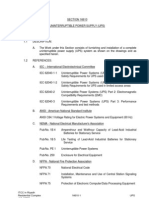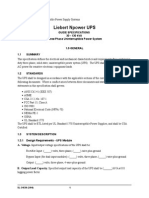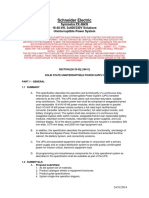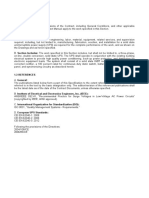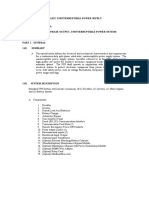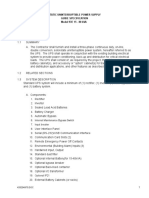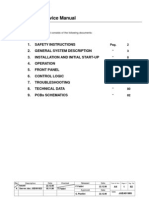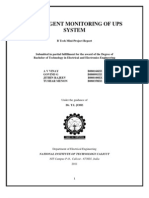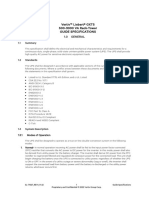ITCC in Riyadh Residential Complex J10-13300 16610-1 UPS
ITCC in Riyadh Residential Complex J10-13300 16610-1 UPS
Uploaded by
uddinnadeemCopyright:
Available Formats
ITCC in Riyadh Residential Complex J10-13300 16610-1 UPS
ITCC in Riyadh Residential Complex J10-13300 16610-1 UPS
Uploaded by
uddinnadeemOriginal Title
Copyright
Available Formats
Share this document
Did you find this document useful?
Is this content inappropriate?
Copyright:
Available Formats
ITCC in Riyadh Residential Complex J10-13300 16610-1 UPS
ITCC in Riyadh Residential Complex J10-13300 16610-1 UPS
Uploaded by
uddinnadeemCopyright:
Available Formats
SECTION 16610 UNINTERRUPTIBLE POWER SUPPLY (UPS) PART 1 - GENERAL 1.1 DESCRIPTION: A.
The Work under this Section consists of furnishing and installation of a complete uninterruptible power supply (UPS) system as shown on the drawings and as specified herein.
1.2
REFERENCES: A. IEC International Electrotechnical Committee IEC 62040-1-1 IEC 62040-1-2 IEC 62040-2 IEC 62040-3 B. Uninterruptible Power Systems (UPS) Part 1-1: General and Safety Requirements for UPS used in operator access areas Uninterruptible Power Systems (UPS) Part 1-2: General and Safety Requirements for UPS used in limited access areas Uninterruptible Power Systems (UPS) Part 2: Electromagnetic Compatibility Requirements (EMC) Uninterruptible Power Systems (UPS) Part 3: Performance Requirements and test methods
ANSI - American National Standard Institute ANSI C84.1Voltage Rating for Electric Power Systems and Equipment (60 Hz)
C.
NEMA - National Electrical Manufacturer's Association Pub/No. 1B 4 Pub/No. 1B 5 Pub/No. PE 1 Pub/No. 250 Amperehour and Watthour Capacity of Lead-Acid Industrial Batteries for Stationary Service Life Testing of Lead-Acid Industrial Batteries for Stationary Service Uninterruptible Power Systems Enclosure for Electrical Equipment
D.
NFPA - National Fire Protection Association NFPA 70 NFPA 71 NFPA 75 National Electrical Code Installation, Maintenance and Use of Central Station Signaling Systems Protection of Electronic Computer/Data Processing Equipment
ITCC in Riyadh Residential Complex J10-13300
16610-1
UPS
NFPA 99 NFPA 101 E.
Health Care Facilities Safety to Life from Fire in Buildings and Structures
IEEE - Institute of Electrical and Electronics Engineers IEEE 59 IEEE 446 Semiconductor Rectifier Components Practice for Emergency and Commercial Power systems Standby, Industrial and
F.
UL - Underwriters Laboratories, Inc. UL 486A UL 486B UL 924 UL 1778 Wire Connectors and Soldering Lugs for Use with Copper Conductors Wire Connectors for Use with Aluminum Conductors Emergency Lighting and Power Equipment Uninterruptible Power Supply Equipment
1.3
SUBMITTALS: A. B. C. Product Data: Submit manufacturer's data on uninterruptible power supply systems and components. Shop Drawings: Submit layout drawings of UPS systems and accessories including, but not limited to, rectifiers/chargers, batteries, and instruments. Maintenance Data: Submit maintenance data and parts list for uninterruptible power supply and accessories including "trouble-shooting" maintenance guide.
1.4
TRANSPORTATION, HANDLING AND STORAGE: A. Handle uninterruptible power supply equipment carefully to prevent damage, breaking, and scoring. Do not install damaged units or components; replace with new. Store units in clean dry place. Protect from weather, dirt, fumes, water, construction debris, and physical damage.
B. 1.5
WARRANTY: A. Entire system and components shall be warranted by manufacturer for period of minimum 1year from the substantial completion against defective materials and workmanship. Warranty shall be jointly signed by the manufacturer and the contractor.
1.6
QUALITY ASSURANCE: A. Manufacturer's Qualifications: Firms regularly engaged in manufacture of uninterruptible power supply systems, of types and ratings required, whose
ITCC in Riyadh Residential Complex J10-13300
16610-2
UPS
products have been in satisfactory use in similar service for not less than 5 years. Manufacturer shall be subject to approval of the Engineer. B. Installer Qualifications: Firm with at least 3 years of successful installation experience on projects with uninterruptible power supply systems similar to that required for this project, and shall be authorized by the manufacturer and approved by the Engineer. Comply with the applicable requirements of following codes and standards: 1. 2. 3. 4. 5. D. IEC 62040: All applicable sections. ISO 9001 NEC as applicable to installation and construction of electrical equipment. NFPA 71, 75 and 101. UL 1778, ANSI, IEEE and NEMA.
C.
Equipment shall conform to the Altitude of site.
PART 2 - PRODUCTS 2.1 GENERAL: A. Provide a three phase, on-line, continuous operation, solid state uninterruptible power supply (UPS) systems of type and rating as shown on drawings or specified herein. The UPS shall operate as an active power control system in conjunction with building electrical systems to provide conditioned uninterruptible power for a limited duration of 30 minutes. The system shall consist of a converter, battery bank, solid-state inverter, automatic static bypass-transfer circuit and integral maintenance-bypass circuit. Finish enclosure in manufacturer's standard finish and color. The entire system shall be designed for maximum reliability in emergency service and shall be designed with modular construction for easy field replacement. UPS system includes the following as standard features: 2.2 Transistorized PWM IGBT/intelligent power-module converter. Digital-signal processing (DSP) using PWM for direct-digital-control (DDC) of all UPS control and monitoring functions. Transistorized PWM IGBT intelligent inverter for output.
B.
SYSTEM OPERATION: A. The UPS shall he designed to operate continuously at rated capacity as an online automatic system in the following modes: 1. Normal: The inverter continuously supplies AC power to the critical load. The converter converts commercial AC power to regulated DC power,
ITCC in Riyadh Residential Complex J10-13300
16610-3
UPS
which then serves as the inverter input and, simultaneously, as a float charge input to the storage battery. 2. Emergency: In the event of a commercial AC power failure, the inverter shall derive its input from the system battery, thus pro viding uninterrupted power to the critical load. This transition shall be accomplished without any switching or coupling, and with no interruption of power to the critical load from either a failure or restoration of the commercial AC power. Recharge: Subsequent to restoration of commercial AC power, the converter shall automatically reactivate and provide DC power to the inverter, simultaneously recharging the system battery. This occurs automatically and without interruption to the critical load. Bypass: In the event that the UPS must be taken off-line due to an overload condition or UPS failure, the critical load shall be transferred to the bypass source via the static switch without interruption of power to the critical load. A paralleling wraparound contactor shall he used to maintain the bypass source. The static switch shall only be utilized for automatic emergency transfers. A retransfer from bypass to inverter shall be performed automatically in overload conditions. A retransfer shall he inhibited if satisfactory synchronization of the inverter and bypass is not accomplished. The use of the static switch shall not be required during the manual or automatic retransfer process, thus increasing reliability. Maintenance bypass. The UPS system shall be equipped with an internal maintenance bypass switch (MBS) to allow safe and reliable maintenance of the UPS. The bypass shall he of the make-before- break, zero-energy type to ensure maximum load reliability and personnel safety.
3.
4.
5.
6.
2.3
FUTURE EXPANSION AND PARALLEL OPERATION: A. In case the UPS system consists of several units, then the individual units shall have a synchronization facility (CARD) built-in to allow the Modules to be synchronized. The Modules shall work in parallel and shall operate on a common DC bus. The UPS shall be capable of a field upgrade to allow parallel operation with additional UPS modules for increased capacity or for redundant operation. The parallel systems shall be capable of operation on a common DC bus or with a separate DC bus for each system module and shall provide proportional load sharing between all available modules. To provide a true fault-tolerant control system, any individual UPS module shall be capable of automatically assuming control of the entire system.
B.
2.4
PERFORMANCE CHARACTERISTICS: Power rating at 0.8 lagging (kVA/KW) Input voltage Input voltage range
16610-4
: As shown on drawings. : 400 volts, 3-phase. 3-wire. : +10 %, -15 %.
UPS
ITCC in Riyadh Residential Complex J10-13300
Input frequency
: 60 Hz 5 percent.
Input power factor: 0.98 lagging, minimum at 100% load; 0.93 lagging, minimum at 50% load without additional harmonic filters. Reflected input current total harmonic distortion (HTD): 3% maximum at 100% load, 6 % maximum at 50% load. Nominal output voltage : 400/230 volts, .3-phase, 3-wire
Nominal dynamic- voltage regulation: 1% for unbalanced loads. Voltage transient response: a. b. -3% for a 50% load step. 5% for a 100% load step. 2% THD maximum with 100% linear load. Typically 4% THD maximum with 100% nonlinear load. 125% for 10 minutes while maintaining voltage regulation. 1000% for one cycle while using the bypass for fault clearing.
Output voltage-harmonics distortion: a. b.
Output overload capability: a. b.
2.5
Full load efficiency: greater than 92%.
ADDITIONAL STANDARD FEATURES: Fault memory and diagnostics. Menu-controlled operation. Active control of output voltage distortion. Automatic input current walk-in. Remote operation. Automatic UPS restart and load pickup after the battery is depleted and utility power is restored. Internal DC disconnect and fuse protection. Remote and local emergency power OFF (EPO). Isolation transformer shall be built-in for all UPS bigger than 80 kVA.
2.6
BATTERY: A. The battery shall be sized to power the fully loaded inverter for 30 minutes as minimum or as indicated on drawings and shall be of the high capacity, sealed, lead-acid requiring no addition of water during service life. Rechargeable battery shall have an expected service life in excess of 10 years and shall be guaranteed for 10 years; 1 year unconditionally and 9 years pro-rata.
B.
ITCC in Riyadh Residential Complex J10-13300
16610-5
UPS
2.7
INSTRUMENTATION AND CONTROLS: A. Manufacturers standard instrumentation and controls suitable to determine that the system is operating in a satisfactory manner. UPS shall have an electronic status display panel indicating all the necessary parameters required for satisfactory operation and monitoring. ENCLOSURE: A. The entire system shall be enclosed in Manufacturers standard free-standing, sheet-steel NEMA 1 or equivalent enclosure, painted finish, with hinged door. The doors shall be key-locked. All potentially hazardous components shall have safety covers and be properly marked with tags to indicate care handling. The battery shall be arranged for easy maintenance. Every possible care shall be taken to main installation and connection easy and fast.
2.8
B.
PART 3 - EXECUTION 3.1 INSTALLATION: A. B. 3.2 The uninterruptible power supply system shall be installed in accordance with the manufacturer's drawings, instructions, and recommendations. All electrical wiring and methods shall conform to the requirements of Section 16050 - BASIC MATERIALS AND METHODS.
TEST: A. The completed installation shall be tested in accordance with the manufacturer's written recommendations. Testing shall be conducted by representatives of the manufacturer. The Owner and the Engineer and shall be notified in advance and shall have the option to witness the test. Certified copies of test procedures and results shall be forwarded to the Engineer. END OF SECTION
ITCC in Riyadh Residential Complex J10-13300
16610-6
UPS
You might also like
- Powerware 9305 20-80 Kwa PDFDocument520 pagesPowerware 9305 20-80 Kwa PDFalex80% (5)
- GXT2-10000T230 Service ManualDocument33 pagesGXT2-10000T230 Service ManualMilton Mejia80% (10)
- Introduction to Power System ProtectionFrom EverandIntroduction to Power System ProtectionRating: 4 out of 5 stars4/5 (2)
- APC by Schneider Electric: APC Symmetra PX Guide Specifications 96/160 KW Uninterruptible Power SystemDocument8 pagesAPC by Schneider Electric: APC Symmetra PX Guide Specifications 96/160 KW Uninterruptible Power SystemAugusto Francisco Diaz LaraNo ratings yet
- Qcs 2014 - Sec21 p18 - Uninterruptible Power SupplyDocument6 pagesQcs 2014 - Sec21 p18 - Uninterruptible Power Supplychandra100% (1)
- Generator MaintenanceDocument24 pagesGenerator MaintenancePablo Gaspar D'Agostini Amengual100% (11)
- Product Information DIGSI 5 V07.30Document48 pagesProduct Information DIGSI 5 V07.30Anoss Olier0% (1)
- ITCC in Riyadh Residential Complex J10-13300 16610-1 UPSDocument6 pagesITCC in Riyadh Residential Complex J10-13300 16610-1 UPSuddinnadeemNo ratings yet
- UPS Specification CSI 263353 03LPDocument18 pagesUPS Specification CSI 263353 03LPJuvencio MolinaNo ratings yet
- CONVENTIONNAL UPS - 100kva To 800kva - Tender Technical SpecificationsDocument8 pagesCONVENTIONNAL UPS - 100kva To 800kva - Tender Technical SpecificationsMuhammad Qumar NazeerNo ratings yet
- Liebert NPower Guide SpecsDocument18 pagesLiebert NPower Guide SpecstwobruinsNo ratings yet
- UFT SpecificationsDocument11 pagesUFT SpecificationsabduNo ratings yet
- Symmetra PX 48kW - Guide SpecificationDocument11 pagesSymmetra PX 48kW - Guide SpecificationAugusto Francisco Diaz LaraNo ratings yet
- CONVENTIONNAL UPS - 10kva To 120 - Tender Technical SpecificationsDocument8 pagesCONVENTIONNAL UPS - 10kva To 120 - Tender Technical SpecificationsMuhammad Qumar NazeerNo ratings yet
- Guide Specifications Symmetra 96 160kVADocument8 pagesGuide Specifications Symmetra 96 160kVAAugusto Francisco Diaz LaraNo ratings yet
- Liebert Exm 50 250kva Single Module Guide Specifications - 00Document18 pagesLiebert Exm 50 250kva Single Module Guide Specifications - 00naveedfndNo ratings yet
- 40-80 kVA 3-Phase UL924 Guide SpecificationDocument16 pages40-80 kVA 3-Phase UL924 Guide SpecificationDiegoJoseMorenoMoralesNo ratings yet
- Liebert Npower Guide SpecificationsDocument16 pagesLiebert Npower Guide SpecificationsJOSE MIGUEL AYALA DURANNo ratings yet
- APC Symmetra LX: Guide Specifications For 4kVA-16kVA Uninterruptible Power SystemDocument14 pagesAPC Symmetra LX: Guide Specifications For 4kVA-16kVA Uninterruptible Power SystemRenato Maillo100% (1)
- Liebert NX Ups Guide SpecsDocument16 pagesLiebert NX Ups Guide SpecstwobruinsNo ratings yet
- Galaxy VX 300 To 1500kW 400 V Guide Specification 12nov2019 PDFDocument17 pagesGalaxy VX 300 To 1500kW 400 V Guide Specification 12nov2019 PDFkargayasnowNo ratings yet
- Galaxy PW Muti Module Technical SpecsDocument30 pagesGalaxy PW Muti Module Technical SpecsRUBEN LOZANONo ratings yet
- Eaton 9155 Ups Guide SpecDocument12 pagesEaton 9155 Ups Guide SpecFernando Joan Ramos RojasNo ratings yet
- 93E 15-80 KVA Guide SpecificationDocument11 pages93E 15-80 KVA Guide SpecificationHafiz SafwanNo ratings yet
- Inter Plant Standard - Steel Industry: 3.1.1 Ambient Temperature - The Reference Ambient Temperature Shall Be 50Document7 pagesInter Plant Standard - Steel Industry: 3.1.1 Ambient Temperature - The Reference Ambient Temperature Shall Be 50Velu SamyNo ratings yet
- UPS Guide SpecsDocument13 pagesUPS Guide SpecsONILEDA1970100% (1)
- Guide Spec 9395P 200-600kW UPS PDFDocument19 pagesGuide Spec 9395P 200-600kW UPS PDFabual3ezNo ratings yet
- Liebert Exm Ups 480 Volt 30 250kva Guide Specifications Sl 26104 0 (2)Document27 pagesLiebert Exm Ups 480 Volt 30 250kva Guide Specifications Sl 26104 0 (2)824943manishaNo ratings yet
- GE VH UPS Guide Spec TemplateDocument12 pagesGE VH UPS Guide Spec TemplateJohn CollinsNo ratings yet
- Schneider Galaxy VMDocument14 pagesSchneider Galaxy VMnn rajeshNo ratings yet
- Eaton 93e 20 60 Kva Guide SpecDocument15 pagesEaton 93e 20 60 Kva Guide SpecMMM ManoNo ratings yet
- E07 upsDocument6 pagesE07 upsphuongdao11071006No ratings yet
- SchneiderDocument18 pagesSchneideruddinnadeemNo ratings yet
- Ups Hurghada City Center Specification - Shaker ConsultancyDocument11 pagesUps Hurghada City Center Specification - Shaker ConsultancyMohamedAhmedFawzyNo ratings yet
- Tender Specifications: Please Rename The File Before Deliver To Third Party (Remember To Delete This Window)Document11 pagesTender Specifications: Please Rename The File Before Deliver To Third Party (Remember To Delete This Window)dhruvNo ratings yet
- GXT3-10000RT230 Guide Spec PDFDocument12 pagesGXT3-10000RT230 Guide Spec PDFAlan BartlettNo ratings yet
- 401985Document82 pages401985Julio Cesar Garcia ReyesNo ratings yet
- QCS 2010 Section 21 Part 18 Uninterruptible Power Supply SystemsDocument5 pagesQCS 2010 Section 21 Part 18 Uninterruptible Power Supply Systemsbryanpastor1060% (1)
- Spec Sheet Without BatteryDocument7 pagesSpec Sheet Without Batteryvishal V PNo ratings yet
- UPS SYSTEM SpecificationDocument4 pagesUPS SYSTEM SpecificationIwan TristiawanNo ratings yet
- Technical Specification For Uninterruptible Power SupplyDocument26 pagesTechnical Specification For Uninterruptible Power SupplyengrrafNo ratings yet
- Static Uninterruptible Power SupplyDocument8 pagesStatic Uninterruptible Power SupplysallammohamedNo ratings yet
- Uninterruptible Power Supply (Ups)Document15 pagesUninterruptible Power Supply (Ups)Ahmed RedaNo ratings yet
- MODULAR UPS - 240KW-480KW - Tender Technical SpecificationsDocument7 pagesMODULAR UPS - 240KW-480KW - Tender Technical SpecificationsMuhammad Qumar NazeerNo ratings yet
- Sec 16611 - UPS SystemDocument16 pagesSec 16611 - UPS SystemFadi FarseNo ratings yet
- Voltage Power Supplies: Regulation of UninterruptedDocument5 pagesVoltage Power Supplies: Regulation of UninterruptedhuseyinkaksaNo ratings yet
- 7011B SERIES: UNINTERRUPTED Peace of MindDocument11 pages7011B SERIES: UNINTERRUPTED Peace of MindJuan CastañedaNo ratings yet
- Modulys-Gp-2.0 Tender-Specification 2014-09 Socm4sx008xr1 enDocument20 pagesModulys-Gp-2.0 Tender-Specification 2014-09 Socm4sx008xr1 enmola znbuNo ratings yet
- Galaxy VM Marine Guide SpecificationDocument12 pagesGalaxy VM Marine Guide SpecificationJosephine Wong Sian CheeNo ratings yet
- Mge Galaxy 5000 PDFDocument17 pagesMge Galaxy 5000 PDFNgoy mulundaNo ratings yet
- CONVENTIONNAL UPS - 1KVA To 10KVA - Tender Technical SpecificationsDocument6 pagesCONVENTIONNAL UPS - 1KVA To 10KVA - Tender Technical SpecificationsMuhammad Qumar NazeerNo ratings yet
- UpsDocument18 pagesUpsVan Phuong PhamNo ratings yet
- Guide Specification PowerWave 33-1Document11 pagesGuide Specification PowerWave 33-1ZIPDASHNo ratings yet
- Intelligent Monitoring of Ups System: Under The Guidance ofDocument40 pagesIntelligent Monitoring of Ups System: Under The Guidance ofTushar MenonNo ratings yet
- 7011a 6-10kva SpecsDocument10 pages7011a 6-10kva SpecsOscar MorenoNo ratings yet
- sl-26158 Rev2 09-21Document13 pagessl-26158 Rev2 09-21ldiipahmedNo ratings yet
- Vertiv Liebert gxt5 500 3000 Va Rack Tower Guide Specifications SL 71027Document13 pagesVertiv Liebert gxt5 500 3000 Va Rack Tower Guide Specifications SL 71027Dendy PurnamaNo ratings yet
- Guide Specification Concept Power DPA Modular 10-25-070827Document16 pagesGuide Specification Concept Power DPA Modular 10-25-070827ZIPDASHNo ratings yet
- Technical Specs Power SystemDocument14 pagesTechnical Specs Power SystemAnand SinghNo ratings yet
- High Power Ups Selection Methodology and Installation Guideline For High Reliability Power SupplyDocument7 pagesHigh Power Ups Selection Methodology and Installation Guideline For High Reliability Power SupplyCyriac SebastianNo ratings yet
- Reference Guide To Useful Electronic Circuits And Circuit Design Techniques - Part 1From EverandReference Guide To Useful Electronic Circuits And Circuit Design Techniques - Part 1Rating: 2.5 out of 5 stars2.5/5 (3)
- XXXXXX: Voltage Drop& Cable Sizing CalculationsDocument5 pagesXXXXXX: Voltage Drop& Cable Sizing CalculationsPradeesh Vijayan (v.prathi)No ratings yet
- Panel Board ShortCircuit RatingsDocument2 pagesPanel Board ShortCircuit RatingsuddinnadeemNo ratings yet
- Panel Board ShortCircuit RatingsDocument2 pagesPanel Board ShortCircuit RatingsuddinnadeemNo ratings yet
- Electrical Engineer CV (M Bilal M)Document4 pagesElectrical Engineer CV (M Bilal M)uddinnadeemNo ratings yet
- Submittal ReviewDocument22 pagesSubmittal ReviewuddinnadeemNo ratings yet
- 16715-Voice & Data CablingDocument16 pages16715-Voice & Data Cablinguddinnadeem100% (1)
- Green Grounding ManualDocument23 pagesGreen Grounding Manualuddinnadeem100% (1)
- 16716-Voice & Data SystemDocument13 pages16716-Voice & Data SystemuddinnadeemNo ratings yet
- Where Indicated Supply and Apply On Concrete Screed A Multi Component Hard Wearing, Smooth, Matt or Satin Finish Polyurethane Based Flooring System at A Thickness of 2.5 MM UtilisingDocument1 pageWhere Indicated Supply and Apply On Concrete Screed A Multi Component Hard Wearing, Smooth, Matt or Satin Finish Polyurethane Based Flooring System at A Thickness of 2.5 MM UtilisinguddinnadeemNo ratings yet
- SECTION 01300 Submittals 1.01 General: Vocational Training CenterDocument11 pagesSECTION 01300 Submittals 1.01 General: Vocational Training CenterulyjohnignacioNo ratings yet
- 16721-Fa SystemDocument17 pages16721-Fa SystemuddinnadeemNo ratings yet
- 15400Document27 pages15400uddinnadeemNo ratings yet
- Panel BoardDocument7 pagesPanel BoarduddinnadeemNo ratings yet
- Nicet AlarmsDocument23 pagesNicet AlarmsWERMERMNo ratings yet
- 16504-Home Automation SystemDocument23 pages16504-Home Automation SystemuddinnadeemNo ratings yet
- Lightning ProtectionDocument3 pagesLightning ProtectionuddinnadeemNo ratings yet
- 16461-Dry Type TransformerDocument8 pages16461-Dry Type TransformeruddinnadeemNo ratings yet
- LightingDocument13 pagesLightinguddinnadeemNo ratings yet
- 16453-Grounding & Bonding Telecommunication SystemDocument6 pages16453-Grounding & Bonding Telecommunication SystemuddinnadeemNo ratings yet
- 16410-Swiches & CBDocument15 pages16410-Swiches & CBuddinnadeemNo ratings yet
- GeneratorDocument19 pagesGeneratoruddinnadeemNo ratings yet
- GroundingDocument6 pagesGroundinguddinnadeemNo ratings yet
- Package SubstationDocument9 pagesPackage SubstationuddinnadeemNo ratings yet
- 16342-Metal Clad MV SWGRDocument14 pages16342-Metal Clad MV SWGRuddinnadeemNo ratings yet
- BuswayDocument5 pagesBuswayuddinnadeemNo ratings yet
- Olympus SP-720UZ Instruction ManualDocument76 pagesOlympus SP-720UZ Instruction ManualnaimenimNo ratings yet
- Set Up Procedure MachineDocument12 pagesSet Up Procedure MachineHân PhạmNo ratings yet
- Resol DeltaSol BS V2Document2 pagesResol DeltaSol BS V2Stefan VargaNo ratings yet
- Manual de Partes de Retro CASE 580 M Serie 2Document886 pagesManual de Partes de Retro CASE 580 M Serie 2Jose Villamil Ruiz80% (5)
- Office Automation Tools NotesDocument75 pagesOffice Automation Tools NotesthedrealityyNo ratings yet
- Quickspecs: HP Pro 8 Rugged Tablet With VoiceDocument14 pagesQuickspecs: HP Pro 8 Rugged Tablet With VoicedevendraNo ratings yet
- ESD Objective QuestionsDocument14 pagesESD Objective QuestionsSanskrithi TigerNo ratings yet
- 2BN1 2BN2 2012Document63 pages2BN1 2BN2 2012Gustavo CastroNo ratings yet
- Brief Papers: A Super Cut-Off CMOS (SCCMOS) Scheme For 0.5-V Supply Voltage With Picoampere Stand-By CurrentDocument4 pagesBrief Papers: A Super Cut-Off CMOS (SCCMOS) Scheme For 0.5-V Supply Voltage With Picoampere Stand-By CurrentEldhose Paul NellimattathilNo ratings yet
- CNC Milling ReportDocument6 pagesCNC Milling ReportMuhazman DinNo ratings yet
- How To Write A Test CaseDocument2 pagesHow To Write A Test CasegsdeeepakNo ratings yet
- Project 3.1.1 History of Automation: ItemsDocument4 pagesProject 3.1.1 History of Automation: ItemsBenNo ratings yet
- Lesson Plan in ComputerDocument3 pagesLesson Plan in ComputerAngelo SorianoNo ratings yet
- FT2000 Complete Alignment Manual 11-3-11Document5 pagesFT2000 Complete Alignment Manual 11-3-11Horacio Fernando Martínez AlasiaNo ratings yet
- Introduction: How To Make A Main Menu in UnityDocument12 pagesIntroduction: How To Make A Main Menu in UnityjorgernesNo ratings yet
- Oxford Bookworm LibraryDocument10 pagesOxford Bookworm LibraryQuyet LuuNo ratings yet
- LPC 18 XXDocument2 pagesLPC 18 XXMalik_123pkNo ratings yet
- Cloud Computing With Openebula - CMP 473 Seminar - 2020-2021 SessionDocument60 pagesCloud Computing With Openebula - CMP 473 Seminar - 2020-2021 Sessiongeehustle06No ratings yet
- Question Bank For EC6301 - Object Oriented Programming and Data StructuresDocument23 pagesQuestion Bank For EC6301 - Object Oriented Programming and Data StructuresAjay GanesanNo ratings yet
- Cluvfy For RacDocument42 pagesCluvfy For RacPalash SarkarNo ratings yet
- Mimi Le Resume FinalDocument1 pageMimi Le Resume Finalapi-396588415No ratings yet
- SPC231SF - SPC232SF MS - v00 PDFDocument229 pagesSPC231SF - SPC232SF MS - v00 PDFChatchawan PhatthanasantiNo ratings yet
- BSIM4 Gate Leakage Model Including Source-Drain PartitionDocument4 pagesBSIM4 Gate Leakage Model Including Source-Drain PartitionalokjadhavNo ratings yet
- SE LecturesDocument108 pagesSE LecturesLourdes VirginiaNo ratings yet
- Employee Database Union Bank LimitedDocument226 pagesEmployee Database Union Bank LimitedsilicijumNo ratings yet
- Emerson Alivio TermicoDocument44 pagesEmerson Alivio TermicoPedro Luis Choque Mamani100% (1)
- How To Port Forward Your Unifi Dlink Dir-615 RouterDocument13 pagesHow To Port Forward Your Unifi Dlink Dir-615 RouterwghazaliNo ratings yet
- Computer Care and SafetyDocument19 pagesComputer Care and SafetyMukalele Rogers33% (3)
- DiaTech Hombre Rear U-Brake InstallDocument3 pagesDiaTech Hombre Rear U-Brake InstallfgfgjlfnglkNo ratings yet







